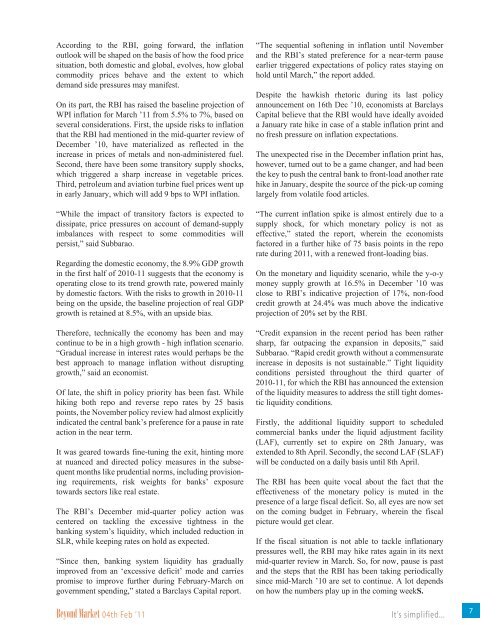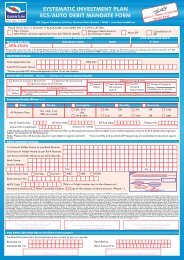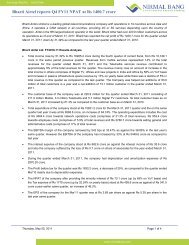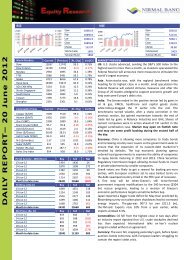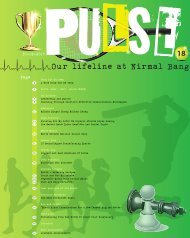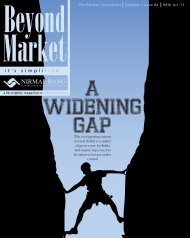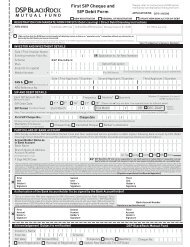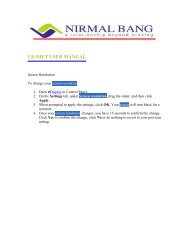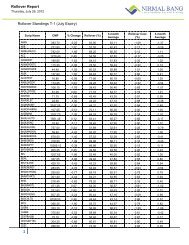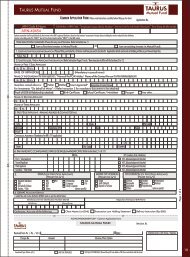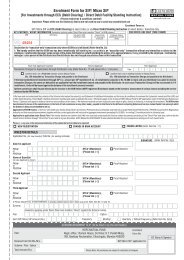to 54646 Contact Person: Sagar Karvat - 077383 80033, e-mail
to 54646 Contact Person: Sagar Karvat - 077383 80033, e-mail
to 54646 Contact Person: Sagar Karvat - 077383 80033, e-mail
Create successful ePaper yourself
Turn your PDF publications into a flip-book with our unique Google optimized e-Paper software.
According <strong>to</strong> the RBI, going forward, the inflation<br />
outlook will be shaped on the basis of how the food price<br />
situation, both domestic and global, evolves, how global<br />
commodity prices behave and the extent <strong>to</strong> which<br />
demand side pressures may manifest.<br />
On its part, the RBI has raised the baseline projection of<br />
WPI inflation for March ’11 from 5.5% <strong>to</strong> 7%, based on<br />
several considerations. First, the upside risks <strong>to</strong> inflation<br />
that the RBI had mentioned in the mid-quarter review of<br />
December ’10, have materialized as reflected in the<br />
increase in prices of metals and non-administered fuel.<br />
Second, there have been some transi<strong>to</strong>ry supply shocks,<br />
which triggered a sharp increase in vegetable prices.<br />
Third, petroleum and aviation turbine fuel prices went up<br />
in early January, which will add 9 bps <strong>to</strong> WPI inflation.<br />
“While the impact of transi<strong>to</strong>ry fac<strong>to</strong>rs is expected <strong>to</strong><br />
dissipate, price pressures on account of demand-supply<br />
imbalances with respect <strong>to</strong> some commodities will<br />
persist,” said Subbarao.<br />
Regarding the domestic economy, the 8.9% GDP growth<br />
in the first half of 2010-11 suggests that the economy is<br />
operating close <strong>to</strong> its trend growth rate, powered mainly<br />
by domestic fac<strong>to</strong>rs. With the risks <strong>to</strong> growth in 2010-11<br />
being on the upside, the baseline projection of real GDP<br />
growth is retained at 8.5%, with an upside bias.<br />
Therefore, technically the economy has been and may<br />
continue <strong>to</strong> be in a high growth - high inflation scenario.<br />
“Gradual increase in interest rates would perhaps be the<br />
best approach <strong>to</strong> manage inflation without disrupting<br />
growth,” said an economist.<br />
Of late, the shift in policy priority has been fast. While<br />
hiking both repo and reverse repo rates by 25 basis<br />
points, the November policy review had almost explicitly<br />
indicated the central bank’s preference for a pause in rate<br />
action in the near term.<br />
It was geared <strong>to</strong>wards fine-tuning the exit, hinting more<br />
at nuanced and directed policy measures in the subsequent<br />
months like prudential norms, including provisioning<br />
requirements, risk weights for banks’ exposure<br />
<strong>to</strong>wards sec<strong>to</strong>rs like real estate.<br />
The RBI’s December mid-quarter policy action was<br />
centered on tackling the excessive tightness in the<br />
banking system’s liquidity, which included reduction in<br />
SLR, while keeping rates on hold as expected.<br />
“Since then, banking system liquidity has gradually<br />
improved from an ‘excessive deficit’ mode and carries<br />
promise <strong>to</strong> improve further during February-March on<br />
government spending,” stated a Barclays Capital report.<br />
Beyond Market 04th Feb ’11<br />
“The sequential softening in inflation until November<br />
and the RBI’s stated preference for a near-term pause<br />
earlier triggered expectations of policy rates staying on<br />
hold until March,” the report added.<br />
Despite the hawkish rhe<strong>to</strong>ric during its last policy<br />
announcement on 16th Dec ’10, economists at Barclays<br />
Capital believe that the RBI would have ideally avoided<br />
a January rate hike in case of a stable inflation print and<br />
no fresh pressure on inflation expectations.<br />
The unexpected rise in the December inflation print has,<br />
however, turned out <strong>to</strong> be a game changer, and had been<br />
the key <strong>to</strong> push the central bank <strong>to</strong> front-load another rate<br />
hike in January, despite the source of the pick-up coming<br />
largely from volatile food articles.<br />
“The current inflation spike is almost entirely due <strong>to</strong> a<br />
supply shock, for which monetary policy is not as<br />
effective,” stated the report, wherein the economists<br />
fac<strong>to</strong>red in a further hike of 75 basis points in the repo<br />
rate during 2011, with a renewed front-loading bias.<br />
On the monetary and liquidity scenario, while the y-o-y<br />
money supply growth at 16.5% in December ’10 was<br />
close <strong>to</strong> RBI’s indicative projection of 17%, non-food<br />
credit growth at 24.4% was much above the indicative<br />
projection of 20% set by the RBI.<br />
“Credit expansion in the recent period has been rather<br />
sharp, far outpacing the expansion in deposits,” said<br />
Subbarao. “Rapid credit growth without a commensurate<br />
increase in deposits is not sustainable.” Tight liquidity<br />
conditions persisted throughout the third quarter of<br />
2010-11, for which the RBI has announced the extension<br />
of the liquidity measures <strong>to</strong> address the still tight domestic<br />
liquidity conditions.<br />
Firstly, the additional liquidity support <strong>to</strong> scheduled<br />
commercial banks under the liquid adjustment facility<br />
(LAF), currently set <strong>to</strong> expire on 28th January, was<br />
extended <strong>to</strong> 8th April. Secondly, the second LAF (SLAF)<br />
will be conducted on a daily basis until 8th April.<br />
The RBI has been quite vocal about the fact that the<br />
effectiveness of the monetary policy is muted in the<br />
presence of a large fiscal deficit. So, all eyes are now set<br />
on the coming budget in February, wherein the fiscal<br />
picture would get clear.<br />
If the fiscal situation is not able <strong>to</strong> tackle inflationary<br />
pressures well, the RBI may hike rates again in its next<br />
mid-quarter review in March. So, for now, pause is past<br />
and the steps that the RBI has been taking periodically<br />
since mid-March ’10 are set <strong>to</strong> continue. A lot depends<br />
on how the numbers play up in the coming weekS.<br />
It’s simplified...<br />
7


